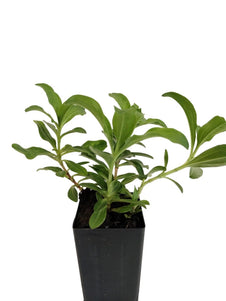





Soapwort
Soapwort

- Low stock - 12 items left
- Inventory on the way

Usually available: All year
Life cycle: Perennial
Height: 40 - 60cm
Position: Sun / part shade
Soil preference: Well drained
This is how we pack and send your Herb Plants to all states except TAS & WA
You will receive
- 1 Soapwort Herb Plant in a 50 X 75mm tube - General growing instructions
All of our Herb Plants are grown organically with certified organic potting mixes and fertilizers
Botanical Name: Saponaria officinalis
Soapwort is a hardy perennial, growing from 40 - 60cm tall with a 1 meter spread. It may be used as a larger groundcover when multiple plants are used, since it grows quite vigorously. The stems are unbranched and hold dark green, lance shaped leaves of 5-12 cm long. The flowers may be pink or white and they bloom for a long period from late summer to autumn. Each flower has 5 petals and they are held in loose terminal clusters on tall stalks. The flowers have a spicy clove fragrance which is said to be stronger at night. They are self-fertile and are either self-pollinating or pollinated by moths.
The botanical name of Saponaria officinalis is due to the saponins found within the plant. ‘Sapo’ is the Latin word for soap and ‘officinalis’ is a reference to the medicinal use of the plant. The saponins are strongest in the root when the plant is in flower. These chemicals create a soap-like lather when the sap is mixed with water. Soapwort is thought to have first been used in the Stone Age when it was likely that people used leaves growing near streams to wipe dirt from their hands, discovering the lathering effects of the plant. It was later planted around Roman Baths for use as a cleanser.
Soapwort often grows in cool places, near water and is native to Asia and throughout Europe, including Britain and Spain. It has been naturalised in the United States, where it was introduced during the colonial period. This plant is a member of the ‘pink’ family which includes dianthus and other dainty pink flowered perennials. Other names include Common Soapwort, Wild Sweet William, Bouncing Bet, Bootia saponaria, Bootia vulgaris, Lychnis officinalis and Silene saponaria. The name Bouncing Bet is derived from the old English name for a washer woman, while the name Common Soapwort may be given to many different species.
Soapwort is an excellent plant for butterflies and moths. It is very suitable for cottage gardens and for large gardens, where it may be able to naturalise under the right conditions. There are several cultivars, including those with double flowers and lower growing varieties.
Growing Conditions
Soapwort is tolerant of a variety of soils. Well composted soil produces good results but soil that is too rich may result in floppy plants that require staking. As they grow taller, it is possible that staking will be required regardless of this factor. Full sun or semi-shade is preferred, and water requirements are low to medium, with good drought tolerance. It is frost hardy to -20 C. Flowers should be deadheaded in order to maintain a tidy appearance and to prolong blooming.
Soapwort is generally low maintenance unless you choose to divide the plants. The plant spreads by rhizomes, although it is not usually very invasive under most garden conditions. Propagation is via division at any time as long as the soil is kept moist while the roots are able to re-establish themselves in the new position. Smaller clumps may perform best if placed in small pots until they are growing well. Soapwort also hybridises easily with other members of this species and there are several known cultivars. Seed may be used to propagate plants, but many will not remain true to type. The seed stratification process required for germination is also complex and time consuming.
Medicinal Uses
Soapwort has a history of medicinal use for a number of treatments. However, it also irritates the digestive system and is rarely used by modern herbalists. Modern scientific research is exploring the use of this plant in other medical capacities. If taken in excess, saponins may destroy red blood cells (which carry oxygen) and cause paralysis of the vasomotor centre which is responsible for the regulation of blood pressure, breathing and heart rate.
Saponins are toxic but they are poorly absorbed by the body and low concentrations pass through without causing harm. Boiling and cooking the leaves and roots also breaks down the chemicals. However, use of Soapwort is not recommended for more than two weeks and it is not advised at any time for pregnant and breastfeeding women.
Soap Use
The leaves and roots are rich in saponins which lather when combined with water. A simple way to create saponin lather is to crush the leaves, using a rolling pin or hands and release the sap, and then add water. The roots may be placed in a modern blender with water or boiled to release the sap. Once complete, leave the mixture to stand overnight and strain away the left over root material. The roots can be harvested and dried for later use.
Cleansers made from Soapwort can be used in place of modern soap and is so gentle that it has been used to carefully clean heritage tapestries stored in museum collections.
Fish Warning
Never plant Soapwort near fish ponds because the saponins may leak into the water if a few stalks fall or trail into the pond. Saponins will poison the fish, resulting in death in most cases. Native tribes were known to use saponin rich plants to kill or put fish into a stupor so that they could catch them more easily. Fish and other animals absorb the toxic components more readily than humans.
All information provided on this website is for informational purposes only. Please seek professional advice before commencing any treatment.






